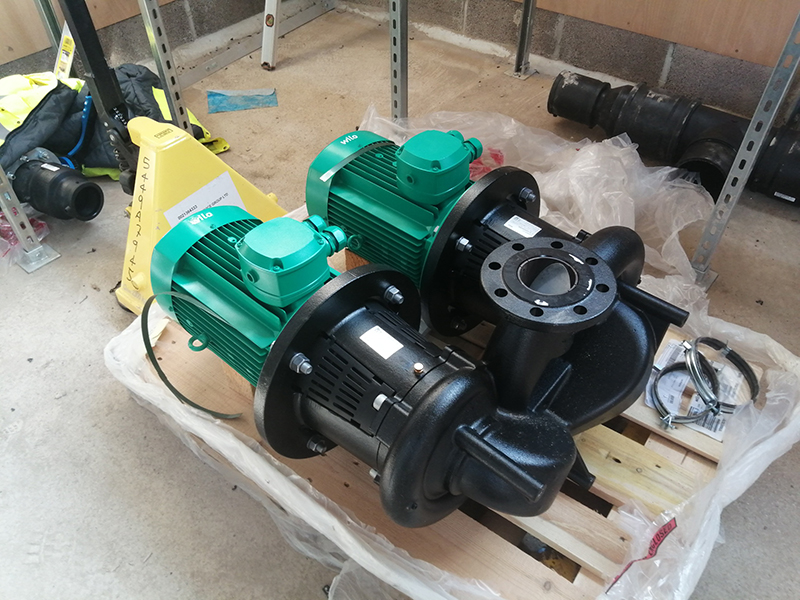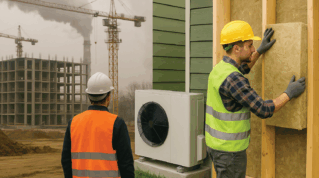Decarbonising a college estate is a huge, multi-million-pound project. Jess Staufenberg talks to three leaders about risking it all for huge cuts to bills and carbon footprint
Even before the current crisis in spiralling energy bills, colleges were sounding warning shots about the costs facing them this year. Cast your mind back to 2021, when a number of energy suppliers went bust amid rising gas prices and when a survey by the Association of Colleges showed colleges faced a rise of £20 million in energy bills this year.
Since then, the war in Ukraine has brought an unwelcome ethical as well as economic element into the equation. FE Week has previously reported how colleges face a “moral dilemma” over exiting contracts with Russian suppliers such as Gazprom ̶ torn between not wanting to fund an invasion and having to negotiate new, pricier energy contracts.
At the same time, carbon zero targets march ever closer. Our climate strategy deep-dive in November revealed many FE providers are playing catch-up as local authorities have announced climate emergencies and the government set its 2050 net zero carbon target.
Then in April the Department for Education published its ‘green strategy’ for education, including a requirement for all capital projects to consider carbon reduction measures, and reminding the sector that the UK aims to reduce emissions from public sector buildings by 75 per cent by 2037 compared to a 2017 baseline.
So decarbonising the college estate looks more urgent than ever – but with squeezed budgets, it’s also harder for colleges to undertake the massive restructuring projects to wean themselves off environmentally harmful, and morally compromised, gas and coal.
So how can it be done?
The ‘why’
FE Week has spoken at length to three colleges with large campuses that undertook multi-million-pound projects around their energy sources.
Luke Rake, chief executive at Kingston Maurward College in Dorset, says it felt like a “pretty poor show” for a land-based college to have a heating system based on oil and liquid petroleum gas. Overall, the college was releasing about 1,000 tons of carbon a year.
“All of our courses involve the environment, plants and animals. But the reality was we were not doing a great thing for the carbon footprint.”
External targets also made an impression, he continues: the National Farmers’ Union set a carbon zero target for 2040, Dorset Council set 2030 and campaign group Extinction Rebellion set 2025. Rake, himself an environmentalist, chose 2025.

Meanwhile Derby College Group was also motivated by practical considerations. According to Iain Baldwin, director of estates, the Broomfield Hall campus was heavily dependent on coal-fired boilers which needed lorryloads of coal to be delivered on the site and shovelled into the ovens.
“It was heavily reliant on manual input to operate it,” says Baldwin, and it meant lorries were constantly visiting the site.
Finance and resilience were other key drivers. “It was a substantial cost – we used to have a delivery every ten days throughout the year,” he says.
“I also didn’t want a whole site with one heating system, because if one thing goes down, it all goes down. One of the reasons for introducing the new provision was spread betting.”

Finally, reducing the carbon footprint at the Colchester Institute in north Essex was “close to the heart of the principal,” Alison Andreas, according to her deputy chief executive. Gary Horne explains the college declared a climate emergency in October last year and set a target to slash its carbon emissions 50 per cent by 2030.
Students were also suffering from the poor insulation and heating systems throughout the college, Horne adds. “There were single glazed metal windows, and many of them either wouldn’t close or were welded shut.” The heating was expensive yet learners often had to wear coats indoors in winter.
Another main motivator was financial. As finance director, Horne has got a horribly tight situation on his books as energy prices rise. The college’s energy bill is forecast to rise from half a million pounds to £1.3 million next year, and he needs all the help he can get in finding efficiencies.

Raising funds
Each college is clear they could never have carried out the huge capital project work without government funding. They all applied to the Public Sector Decarbonisation Scheme, which was launched by the government in 2020 and has had three funding rounds so far.
Kingston Maurward College secured just over £2 million from the fund, with £300,000 extra put in by Dorset Council, to instal ground-source heat pumps. Work began last January and completed in March.
Colchester Institute got £3.7 million, and put in £1.3 million itself by selling some land. The funds allowed the college to replace its gas-fired boilers with air-source heat pumps as well as replace single glazed windows and instal insulation panels. Work began in August 2021 and, due to Covid delays, only completed in March this year.
Meanwhile, Derby College Group secured £3.6 million from the fund, to replace its coal-fired boilers with six air-source heat pumps and three water-source heat pumps, as well as to install 101 solar panels, LED lighting and insulation. Work also began in August last year, with the new technology switched on in January this year.

For the uninitiated, an air-source heat pump is like reverse air conditioning. It absorbs heat from the air outside a building, which is used to heat either the air or water inside the building. Because it runs on electricity, it can be connected to a renewable energy source and so provides a low-carbon alternative to fossil-fuelled heating.
A ground-source heat pump transfers natural heat from the ground, again using renewable electricity to compress fluid, run it deep into the earth, raise it to a higher temperature and return it to the building.
Getting ready
“You need to go into this stuff with your eyes open and a good plan because the timeline is tight, and you need to have all your ducks in order,” says Rake, for whom this was his first major build as a principal.
In his case, permissions were the first hurdle. The main building at Kingston Maurward College is a grade I listed mansion and other buildings are grade II*, so planning permission was needed from national charity Historic England as well as the local conservation officer at Dorset Council. Thankfully, they both agreed.
Rake and his team also had to work out the most financially efficient way of getting the work done, eventually settling on eight contracts with five different contractors as the “best for the public purse”.
At Derby College Group, the 200 acres of parkland means there’s a lot of wildlife on site, Baldwin says, and so the team had to run bat surveys to establish the migratory paths of bat colonies and ensure they were safe.

Meanwhile Colchester Institute took a ‘fabric first’ approach and re-insulated its main building before tackling the energy supply. Another requirement of the fund was to employ at least 50 local construction staff – the college managed to find 71 staff locally, hitting a key performance indicator and allowing work to go ahead.
The final but crucial piece of preparation is to “win the hearts and minds” of staff and students, adds Horne. This will help with everyone understanding any inconveniences further down the line.
Works on site
At Colchester Institute, the main challenge was teaching in a building where all the windows and insulation were being ripped out and replaced, continues Horne.
“We had to move classes into other blocks, and we took out two storeys at a time in a five-floor building,” he explains. It also helps to have “an understanding contractor who will down tools” around the exam period, he adds.
Covid also slowed the work down. The project was originally meant to be completed by November 2021 but computer chips coming from the continent for the new system were delayed by nearly eight weeks, pushing the completion date to March this year.
At Kingston Maurward College, the main challenge was the mud. The site needed 144 boreholes to be drilled, which were 130 metres deep to where the earth’s temperature is warmer and liquid heats to 63 degrees Celsius. When Storm Eunice arrived in February this year, the college grounds “looked like the Somme,” says Rake drily.
“I’m not overstating how much of a challenge the mud was. There was a lot of mess, mud trampled into everything.”

The college was under particular pressure to keep the site presentable as it doubles up as a wedding venue, so to ensure minimal loss of income the works were scheduled for winter, when bookings are scarce, explains Rake.
Meanwhile, the campus at Derby College Group has many learners with additional needs, who needed extra support to ensure they were not at risk from all the building works happening on site, explains Baldwin.
“We had to be very mindful of learners who may be deaf and may not hear the lorry coming,” he says.
Results and the future
By replacing four gas-fired boilers with air-source heat pumps run on electricity from wind farms off the coast of Essex, Colchester Institute has cut down on 290 tonnes of carbon per year. That’s an 18 per cent reduction of the college’s annual carbon footprint overall, amounting to about £50,000 in savings a year.
So to become carbon net zero, the college wants to do the same work “four times over”, at a cost of approximately £5 million each time, explains Horne. It shows the huge sums of money involved in effective decarbonisation.
“Our long-term aim is to be off grid if we can,” he adds. This would enable the college to be completely independent of fluctuating national grid prices and the fossil fuel market, and the senior leadership team are already looking at solar panels in pursuit of that goal.
Another key benefit was educational: eight construction apprentices were employed by the contractors on site and enrolled with the college as part of the project.

Next, at Kingston Maurward College, more than 200 tonnes of carbon have been cut per year, or around 25 per cent of its carbon footprint. It amounts to around £25,000 in savings in the short term, with chief executive Luke Rake anticipating greater savings in the longer term.
The college has also seen an uptick in recruitment to its construction courses, possibly as a result of the reputational pull of the large-scale environmental project, he says.
Meanwhile at Derby College Group, a staggering 659 tonnes of carbon have been cut, resulting in £14,000 of savings a year. The project has also “improved site safety because we don’t have lorries delivering coal, and the environment is better as we took down a ten-metre high chimney stack,” explains Baldwin.
Improvements
All the colleges praised the expert support provided by Salix, the non-departmental public body which awards the Public Sector Decarbonisation Scheme funding (it’s funded by the Department for Education and the Department for Business, Energy and Industrial Strategy).
But the criteria for winning the funding can be tough, and may change for each new funding cycle, they add.
“It’s first come, first served, so you’ve got to get in early,” explains Horne. “It means you need to do all the legwork upfront and you’re developing plans at risk.”
Meanwhile the externally imposed timeframes for completing the works are tight and “do put you under pressure,” says Rake (whose team had from January to end of March 2022 to get everything done).
These individual case studies are inspiring – but the mission now must be to convert such projects into a whole-sector transformation.
It’s first come, first served, so you’ve got to get in early
Yet we’re still a long way off. According to Salix, 63 colleges applied for decarbonisation funding from Salix in 2020/21, but only seven were successful, with £10.2 million handed out.
Meanwhile in 2021/22, 27 applied and 16 were successful, with £12.1 million handed out. The next funding round opens for applications in September 2022.
So as ever, the government is making FE providers fight one another for a pot of money many times smaller than the amount needed to allow them to do what’s necessary.
As a reminder, £13.5 billion was spent in one year on Covid testing, showing what money can be made available.
The climate emergency is surely even more serious than Covid. Rather than making colleges write yet more bids, perhaps government should allocate sufficient decarbonisation funding to every college estate, so that the sector has a real hope of meeting the 2037 deadline.

















Your thoughts